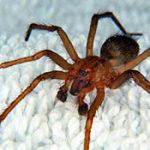The hobo spider (Tegenaria agrestis) is a member of the genus of spiders known colloquially as funnel web spiders, but not to be confused with the potentially deadly Australian funnel-web spider. It is one of a small number of spiders in North America whose bites are generally considered to be medically significant. Individuals construct a funnel-shaped structure of silk sheeting and lie in wait at the small end of the funnel for prey insects to blunder onto their webs. Hobo spiders sometimes build their webs in or around human habitations. Although this species of spider has a reputation for aggressiveness, they will normally avoid contact with humans. Most bites occur when the spider is accidentally crushed or squeezed by a human. The spider’s venom is strong enough to cause considerable local pain and, purportedly, necrosis.
The toxicity and aggression of the hobo spider are currently disputed by arachnologists. One common name, the aggressive house spider may arise from a misinterpretation of the Latin name agrestis, (lit. “of the fields”) as “aggressive”. If a hobo spider is tending an egg sac, it may become aggressive if it perceives the egg sac as being threatened. However, they generally do not bite unless forced to protect themselves, and in the majority of cases the hobo spider does not actually inject venom when it does bite
In the United States, the hobo spider has been considered to be a dangerous species based on a toxicology study on rabbits where lesions appeared after spiders were induced to bite the rabbits. This laboratory study has led to the proposal that in some parts of the U.S. nearly all bites imputed to the brown recluse spider are in reality the hobo spider’s bite. The CDC and other U.S. government agencies have also used this same study as the basis for a report claiming that the hobo spider bite causes necrosis in humans, despite the absence of any confirmed cases. Subsequent attempts to replicate the study by injecting sufficient venom to ensure envenomation have failed to produce necrotic lesions, and there is even question as to whether the lesions observed in the original study were necrotic.
In Canada, there are scientists who claim that no hobo spider bites lead to dermal necrosis. Hobo spiders are common in Europe, though bites are relatively unknown, and there are no confirmed reports of them causing necrosis despite hundreds of years of coexistence there. The only documented case of a verified hobo spider bite leading to necrotic skin lesions involves a person who had a pre-existing medical condition (phlebitis) that can also cause the appearance of skin lesions. Hobo spider bites are not known to be fatal to healthy humans. The necrosis in purported cases is similar to, but milder than, that caused by the brown recluse spider, and in severe cases can take months to heal. Other reported symptoms include intense headaches, vision abnormalities, and/or general feelings of malaise.

